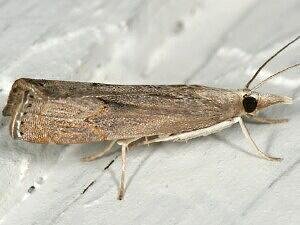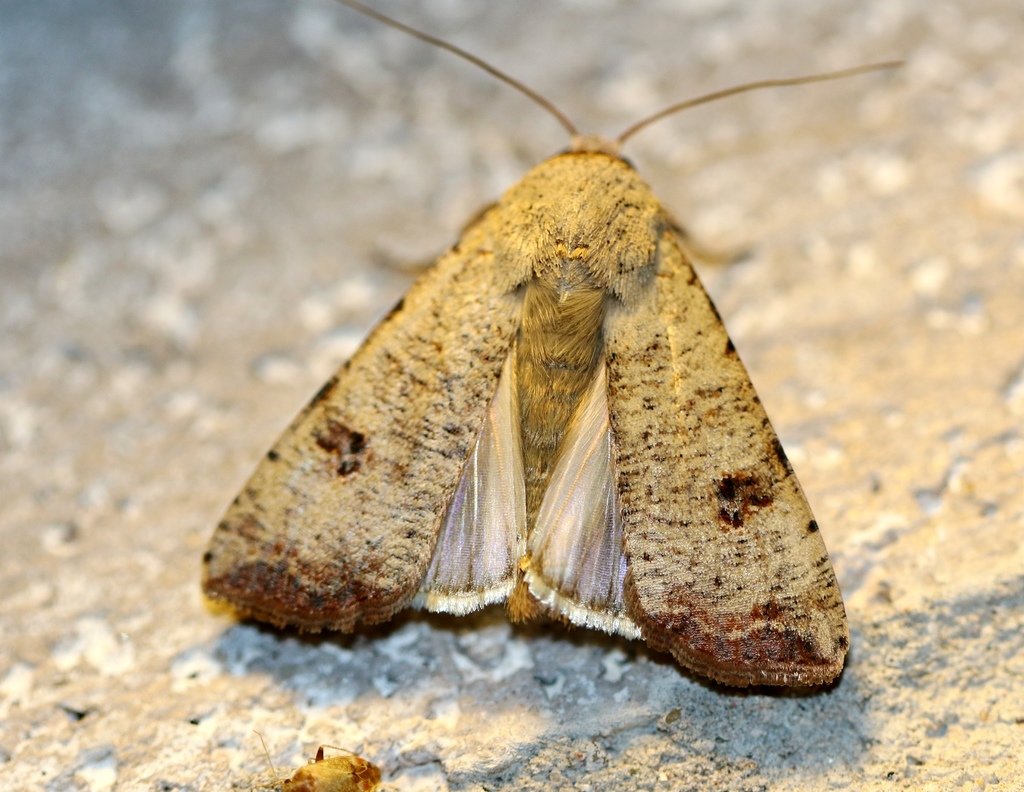When you think of pollination, you often think of butterflies or bees flying around your garden. While these insects are important to flowers and our food supplies, new research shows just how much plants and crops rely on insects that fly at night for pollination.
Most flowering plants count on pollinators for reproduction. Recent years have seen a dramatic drop in pollinator populations. The factors behind the loss have been linked to habitat loss, pesticides and climate change. Research estimates 3-5% of fruit; nut and vegetable crop production is lost globally due to inadequate pollination.
A recent study at the University of Sussex, UK, discovered moths are more efficient pollinators than bees. The team studied both daytime and nocturnal pollinator visits. They discovered that 83% of all pollinator visits occur during the day. Although only 17% of pollinator visits occur at night, the study also noted that moths were able to pollinate flowers more quickly than daytime insects.
The reason nocturnal moths are more efficient pollinators is that moths collect so much static electricity while in flight that pollen is pulled through the air to them. The researchers noted that moths do not need to touch flowers in order to pollinate them. The pollen is pulled across the air gaps as the moths fly several millimeters or even centimeters above.
The researchers concluded nocturnal pollination is understudied. As moths have been shown to transport pollen from a wide variety of plant species, further research is needed to fully appreciate the role they and other nocturnal insects play.
To understand just the important role moths play in pollination, the University of Sheffield, UK, found moths account for a third of all urban pollination. However, a lack of native plant species and diversity of plant life in cities, coupled with scent-stifling air pollution, is still leaving moths struggling to find their next meal.
And finally, experts are warning of an “alarming” global decline in moth population and diversity.
Differences between Butterflies and moths
Most butterflies are colorful and active during the day. Most moths are active at night or during twilight hours and are generally more camouflaged than colorful.
Butterflies have “clubbed” antennae with thickened ends. Moths typically have feather-like or pointed antennae.
Most butterflies have thin, hairless bodies. Moths often have stout, hairy bodies.
Butterflies usually rest with their wings closed upright. Moths mostly rest with their wings open or else fold them tent-like over their bodies.
To highlight the importance of moths as pollinators, TLCNP has held two evening moth roundups. Below is a list of nocturnal critters (moths, beetles and other insects) that were seen those evenings.
Black-bordered Lemon Moth
Marimatha nigrofimbria 10-12 mm wingspan. This small Glyph moth is common and can be seen from Texas to New York. Host plants: Crabgrass and Morning Glory. Seen at TLCNP in April 2025.
Blacked-bordered Lemmon Moth.
Bluegrass Webworm Moth
Parapediasia teterrellus 21 mm wingspan. The larvae feed on native and Bermuda grasses. Adults are on wing from May to October in two generations per year. This moth can be found from New England to Florida and as far west as New Mexico. It likes lawns, golf courses, grassy areas in general. Seen at TLCNP in November 2024.
Bluegrass Moth.
Common Idia Moth
Idia aemula 20-30 mm wingspan. This medium sized, delta shaped, litter moth is found from Texas to Canada. On wing from April to November. Feeds on dead leaves, fungi and other organic matter. Seen at TLCNP in April 2025.
Common Idia Moth.
Dark Sod Webworm moth
Herpetogramma phaeopteralis 18 mm wingspan. This species can be found from Texas to Colorado. They have a snout-like projection on the head. When disturbed they fly short distances in a zigzag pattern. They are usually seen in the early morning hours flying over dark-green healthy grass. Seen at TLCNP in November 2024.
Photo by Alexis Smith.
Eight-Spot Moth
Amyna axis 20-25 mm wingspan. This moth is a species of owlet moth that is found in southern North America, from Florida to Arizona. It migrates north to Canada in late summer and fall.
The larvae feed on several types of perennial plants, hibiscus, sunflowers and hackberries. Adults are on wing from August to October. Seen at TLCNP in November 2024.
Photo by Alexis Smith.
Green Cutworm Moth
Anicla infecta 30-35 mm wingspan. It can be found from Texas to Northeastern North America. Can be found taking nectar from flowers during daylight hours. Hosts include: beet, clover, grases and tobacco. Seen at TLCNP in April 2025.
Green Cutworm Moth.
Georgia Archips Moth
Archips georgianus 18 mm wingspan. They can be found from Texas to New Jersey. Host plants include: blueberry bushes, hickory trees and oak trees. Adults on wing from May to August. Seen at TLCNP in April 2025.
Georgia Archips Moth.
Juniper Budworm Moth
Cudonigera houstonana 20 mm wingspan. Can be found from Texas to New Jersey. Larvae feed on tips of cedar trees, construct silken tubes, and pupate in their feeding shelters. Adults have been recorded on wing from April to November. Seen at TLCNP in April 2025.
Juniper Budworm Moth.
Nigrita Bagworm Moth
Cryptothelea Nigrita 16 mm wingspan. This moth’s antennal sensory hairs are erect and very distinguishing. Found from Texas to Florida. This moth feeds on evergreen foliage and buds. See at TLCNP in April 2025.
Nigrita Bagworm Moth.
Orange-spotted Idia
Idia dimiunendis 16 mm wingspan. This delta shaped, litter moth is found from Texas to Nova Scotia. Seen at TLCNP in April 2025.
Orange-Spotted Idia moth.
Pannaria Wave Moth
Leptostales pannaria 18 mm wingspan. Wave moths are usually small to medium-sized and rest with wings flat and spread wide. Host plants: black-eyed pea and other native legumes. Seen at TLCNP in April 2025.
Pannaria Wave Moth.
Smoky Tetanolita Moth
Tetnolita mynesalis 22 mm wingspan. This delta shaped, litter moth can be found from Texas to New York. Host plant is dead leaves. Seen at TLCNP in April 2025.
Smoky Tetanolita Moth
Southern Pine coneworm Moth
Doryctria amatella 30 mm wingspan. Common in North America wherever pine trees grow. Feeds on various parts of pine trees. Considered a pest in Southeastern US. Seen at TLCNP in April 2025.
Southern Pine Coneworm Moth.
subterranean dart moth
Feltia subterranea 40 mm wingspan. It is common to both South and North America, from Mexico to Massachusetts. Migrates annually with no known hosts. The larvae feed on a wide range of plants. Seen at TLCNP in April 2025.
Subterranean Dart Moth.
Texas Grass Tubeworm Moth
Acrolophus Texanella 20 mm wingspan. Can be found from Texas to Maryland. Adults fly from April to October. Seen at TLCNP in April 2025.
Texas Grass Tubeworm Moth.
Twirler Moth
A family of moths with a wingspan: 10-20 mm. They are small moths with narrow, fringed wings. They can be often found resting on the ground or spinning in circles on leaf surfaces. The larvae of most species feed internally on various parts of their host plants, sometimes causing galls. The adults take flight year round. This moth can be found from Texas to Florida. Seen at TLCNP in November 2024.
Twirler Moth.
Dirt-colored Seed Bug
This is a common name for over 2,100 small bugs. These can be found in North, Central and South America. They are very common in the Southern United States. They can be easily identified by the white triangle in the middle of their wings. They generally feed on seeds from a wide variety of plants.
They are often called true bugs. True Bugs are insects that have two pairs of wings, an outer pair and inner pair. The outer wing covers are held over the back and often partly folded. True bugs have hypodermic-needle-like mouthparts that allow them to extract subsurface fluids from plants and animals. True Bugs undergo incomplete metamorphosis, with their young looking similar to adults, but without wings. Seen at TLCNP in November 2024.
Photo by Alexis Smith.
Punctiforme Harp Ground Beetle
Agonum punctiforme 8 mm in length. This nocturnal beetle is common in the US and can be found from California to Florida. The wing coverings are striated. Seen at TLCNP in April 2025.
Punctiforme Harp Ground Beetle.
Rain Click Beetle
Scaptolenus lectonei 16 mm in length. This small beetle is a rare find. In order to see this beetle you have to be in the right place at the right time. It can be found in Texas, Oklahoma and Mexico. It likes to swarm after a rain - a couple of hours before sunrise or just after sunset. The swarming period is always late in the year, Oct-Dec. Seen at TLCNP in November 2024.
Rain Click Beetle. Photo by Alexis Smith.
Rustic Borer Beetle
Xylotrechus colonus 15 mm in length. The wing coverings have bands of gray and black. Can be found in Texas and most US states north and east of Texas. The larvae of this beetle feed on the sapwood of oaks and the adults adults feed on the nectar of goldenrod. Seen at TLCNP in April 2025.
Rustic Borer Beetle.
Twenty-spotted Lady Beetle
Psyllobora vigintimaculata 3 mm in length. Common to most North America, except Florida. They can be found on any plants that are infected with mildews (especially powdery mildew), from ground level to tree canopies. Seen at TLCNP in April 2025.
Twenty-spotted Lady Beetle. Photo by Tim Murray.
General information on moths, beetles and other insects was sourced from the following recommended field guides:
Common Insects of Texas and Surrounding States: A Field Guide (Corrie Herring Hooks Series, 71)
by John C Abbot, Kendra Abbot.
Containing 1,300 species and more than 2,700 photographs, this guide offers a wealth of information about the characteristics and behaviors of Texas's insects. Each chapter introduces an order with a discussion of general natural history and a description of other qualities helpful in distinguishing its various species, while every species' entry provides a state map showing where it is most likely to be found, a key displaying its seasonal distribution, information about its habitat, and corresponding photos. Featuring colored tabs for quick reference, a glossary, and information about other arthropods, this guide is the perfect companion for anyone wanting to identify and learn more about the many insects of Texas.
Peterson Field Guide To Moths Of Northeastern North America.
by David Beadle, Seabrooke Leckie.
There are thousands of moth species in the northeast of North America, and while it might seem that they are all drab grays and browns, there is actually a startling variety. They come in a rainbow of colors, from brilliant oranges and pinks to soft greens and violets. With helpful tips on how to attract and identify moths, range maps and season graphs showing when and where to find each species, and clear photographs that use the unique Peterson arrow system for easy identification, this guide provides everything an amateur or experienced moth-watcher needs.























